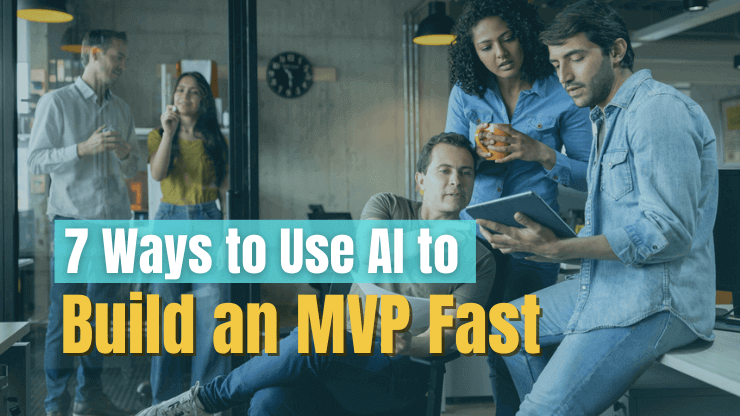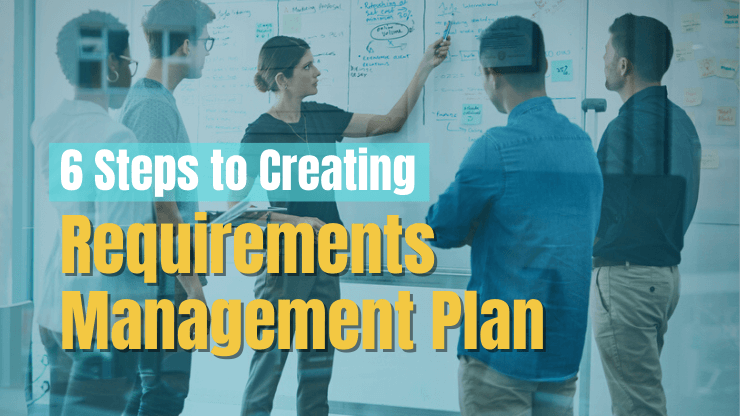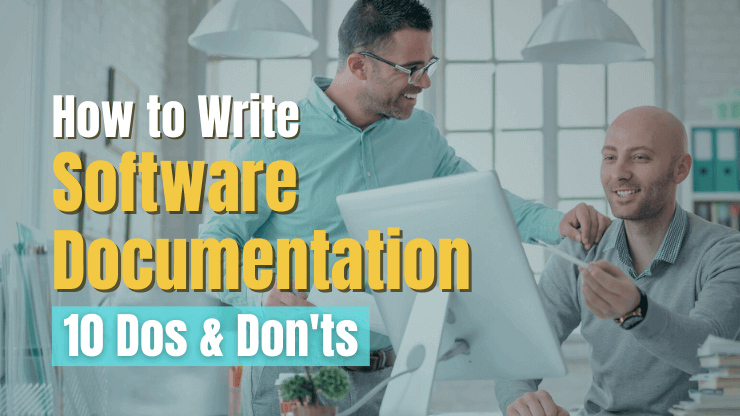Building an MVP is all about speed. The faster you get your product in the hands of real users, the quicker you can gather feedback, validate your idea, and make necessary improvements. With the power of AI, you can streamline your MVP process and get your product into the hands of real users at lightning speed.
In this article, we’ll cover 7 tangible ways to help you do just that, so you can nail your MVP and get it into the market fast. Let’s jump right in!
- What is a Minimum Viable Product?
- Why Build a Minimum Viable Product?
- 7 Ways to Use AI to Build MVP Faster
- 1. Fast-Track Your Target Market Research
- 2. Come Up with Unique Marketing Angles
- 3. Use an AI Website Builder to Design a Landing Page
- 4. Leverage AI Tools to Develop User Storyboards
- 5. Rapidly Generate UX/UI Design Ideas
- 6. Use Predictive Analytics to Select the Core Features
- 7. Develop AI-Driven Personalization to Improve User Engagement
- Conclusion
What is a Minimum Viable Product?
Although originally coined by Frank Robinson in 2001, the term was brought to the mainstream by Eric Ries in his popular book “The Lean Startup” released in 2011. In short, a minimum viable product (MVP) is defined as a product with just enough features to be usable by real end-users.
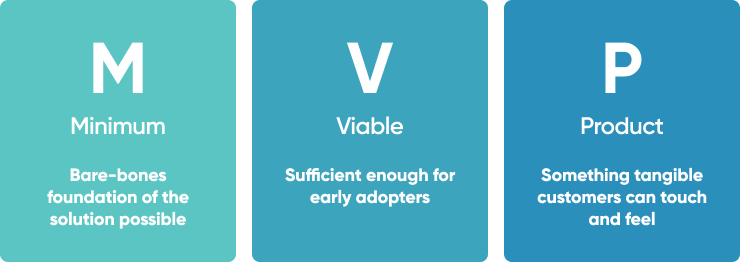
Typically, a minimum viable product builds on the development work done during prototyping. The idea is to build a version of the product with the most basic functionality, release it into the market and use real customer feedback to inform later versions of the product.
Utilizing a minimum viable product is one way of embracing validated learning in the development process. As you learn more about what the early adopters within your target audience like and don't like, what works and what doesn’t, you can adjust your product to better align to the market.
Minimum viable products can come in many forms. To see some specific minimum viable product examples, check out our article - 7 Most Inspiring Minimum Viable Product (MVP) Examples.
Why Build a Minimum Viable Product?
Building a minimum viable product allows you to more quickly enter the market. A few key benefits include:
- Get useful feedback from your target users on the product’s basic features.
- Attract early adopters who will likely be your greatest advocates long term.
- Test the waters before committing (time and budget) to a complex future product.
- Embrace validated learning from the very beginning of the product development lifecycle.
- Attract investors who prefer to see a shipping product instead of just business ideas.
Your minimum viable product might not reap all of these benefits, but even a few can help to reduce overall product development costs (you focus on only the core features!) and get your product to market faster (who doesn’t want to see revenue faster?). For these reasons, embracing the MVP development process is a no-brainer for most teams.
7 Ways to Use AI to Build MVP Faster
In the hyper-competitive startup landscape, speed and efficiency in product development can be the difference between success and obscurity.
AI has the potential to change the very process of not just building an MVP but crystalizing your MVP concept, marketing plan, and ability to meet real-time market demands. If done right, AI tools can be used right from the very beginning of MVP development, and even past the launch.
So, in this section, we'll explore seven compelling ways to intertwine AI with MVP development, ushering in a new era of rapid, data-driven product iterations:
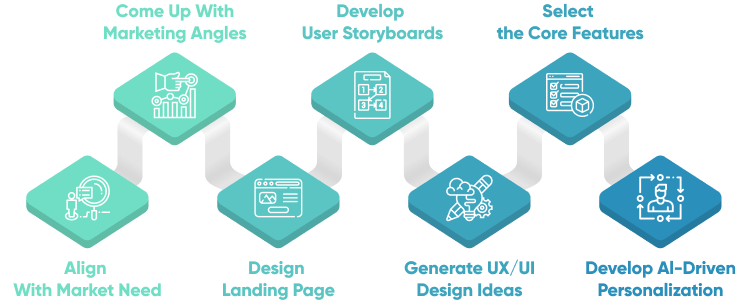
Fast-Track Your Target Market Research
A clear grasp of market needs is pivotal when developing a new product. Understanding these needs meant spending a lot of time on traditional research methods like surveys and focus groups.
You can leverage AI to fast track their audience investigation work. The right AI tool will help you access and analyze data at scale - without the manual effort of sifting through vast data to glean insights from competitive products, user feedback, and even social media trends.
How to get started:
- Analyze user reviews - Deploy AI to scrutinize reviews on platforms like Amazon, Yelp, and Google to capture detailed insights on user expectations and pinpoint potential challenges in similar products already on the market.
- Decode emotional drivers - Utilize AI-driven sentiment analysis tools to discern how users feel about particular features or products, enriching your MVP's design and function.
- Simulate real users - Instead of the product team spending time on lengthy user interviews, use AI to gather input and opinions from AI-generated interviews.
AI Tools to Try:
- Chattermill - Transform your competitors unstructured user feedback into meaningful intelligence that can help you build better product.
- Synthetic Users - Offers simulated user feedback for product development. Ideal for early-stage MVPs seeking user insights without a broad user base.
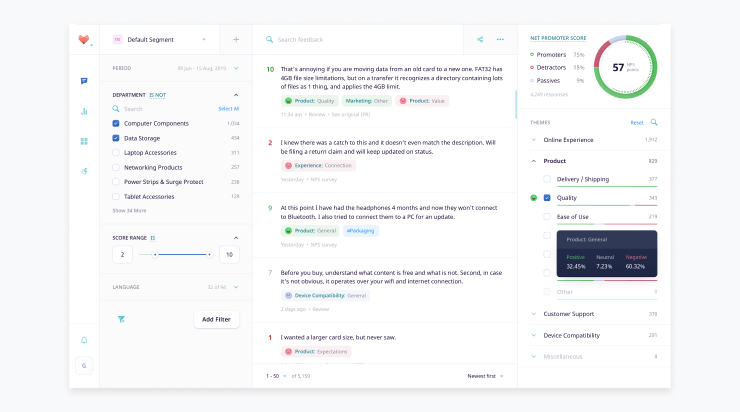
PRO TIP: Emotion is a subtle guidepost. Instead of just categorizing user sentiments as positive or negative, try to map them to more specific emotions like joy, frustration, or confusion. This can help you narrow in on specific features that will best solve user challenges or provide positive user experiences (with the least effort possible!).
Read More: How to Design a Web App That Users Will Love - 7-Step Process
Come Up with Unique Marketing Angles
When launching an MVP, it's essential to position it correctly in the digital market. Traditional brainstorming can help, but it sometimes misses key insights because of preconceived notions or limited data. These oversights can lead to wrong marketing decisions or overlooked opportunities.
AI tools offer a solution by analyzing large amounts of data efficiently. They can spot trends, understand gaps in the market, and get a clearer sense of what customers really want. Using AI, businesses can get insights into where their MVP fits best in the market, and which marketing approaches might work best. In short, AI provides a clearer, data-backed roadmap for launching and promoting an MVP.
How to get started:
- Use AI to iterate faster - Harness the power of AI not just for initial idea generation but also for quickly evaluating and ranking those ideas, ensuring that the most promising concepts take precedence.
- Analyze competitors strategically - Deploy AI to conduct an in-depth analysis of the competitive landscape, unveiling hidden market opportunities or unique positioning angles that may have been missed.
- Tap into emotional insights - Leverage AI-powered sentiment analysis to delve deeper into customer emotions, crafting marketing narratives that genuinely resonate.
AI Tools to Try:
- Jasper Marketing Angles Template - Brainstorm different angles to add vibrancy to your marketing.
- ContentForge’s AI-powered marketing models - Find your next marketing angle or copywriting formula by using popular marketing models.
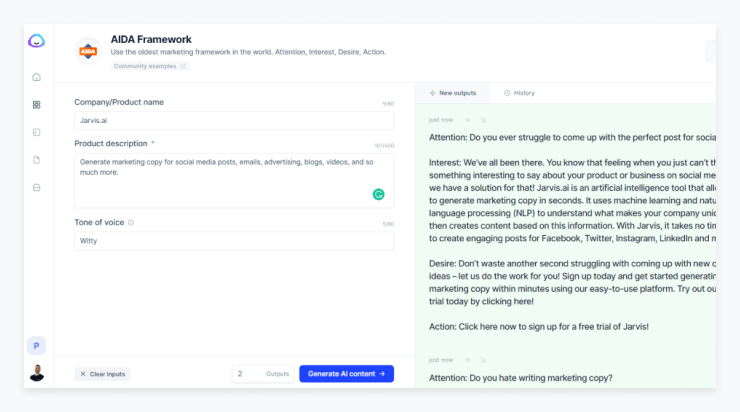
Use an AI Website Builder to Design a Landing Page
The first impression lasts, and for many businesses, this adage plays out on their landing page. Traditionally, creating a striking landing page demands a blend of design acumen, proficient coding, and stellar copywriting. Today, AI website builders can make this whole process dramatically easier.
These platforms leverage artificial intelligence to demystify design decisions, position content strategically, and ensure a seamless experience across multiple devices. For startups, businesses without a web development team, or those keen to validate a concept briskly, AI website builders are an invaluable solution.
How to get started:
- Leverage AI A/B testing - Take advantage of AI-driven A/B testing to quickly identify and implement the most optimal landing page version. This ensures that every design choice or content arrangement is maximally effective in engaging your target audience.
- Convey value proposition - With the assistance of AI, pinpoint the most impactful way to articulate your value proposition. This helps in presenting your marketing angle compellingly and persuasively, ensuring it resonates deeply with your audience.
- Prioritize responsive design - Rely on AI website builders that prioritize responsive design. By doing so, you not only guarantee a landing page that looks and performs excellently across devices but also sidestep potential pitfalls that less experienced internal teams might encounter.
AI Tools to Try:
- Headlime - AI-powered landing page builder helps you create custom landing pages for your business in minutes — no writing, designing or coding required.
- Wix ADI (Artificial Design Intelligence) - Part of Wix's suite, this tool tailors websites or landing pages by soliciting user preferences. Drawing from its extensive design database, it crafts bespoke sites.
- Optimonk's Smart A/B Testing - A solution geared towards discerning which landing page configurations resonate most with your audience, making MVP validation more precise.
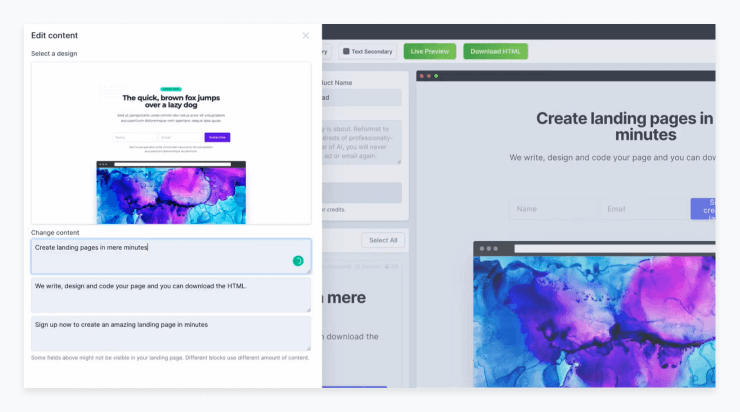
Leverage AI Tools to Develop User Storyboards
Storyboarding plays a crucial role in product development and UX/UI design process, serving as a visual map of the user's journey within a product.
By delving deep into user data, AI tools can anticipate user behaviors and autonomously draft sections of the storyboard. This not only aids in conceptualizing the user experience but also in identifying potential pain points and areas for improvement quicker, helping you to deliver MVPs that resonates with target audience.
How to get started:
- Maximize data input - Feed ample user behavior data into your AI tool, refining its ability to provide the most accurate storyboard suggestions, and enhancing user flow insights.
- Kickstart with AI - Use AI as your primary tool to generate initial storyboard drafts. Once this foundation is laid, manual adjustments can introduce finer details and contextual nuances.
- Merge AI and traditional techniques - While AI offers a fast-track method to understand user flow, coupling it with traditional user research techniques ensures a comprehensive and in-depth understanding of the user experience.
AI Tools to Try:
- Notably.ai: - Essential for MVPs to craft compelling content narratives. It uses AI-driven insights to highlight unique selling points and refine messaging.
- UXPressia - Beyond being a conventional journey mapping instrument, UXPressia melds AI to dissect user data. This results in a dynamic storyboard with potential touchpoints and user actions, marrying AI's sharpness with traditional UX tools.
- Userdoc - A platform tailored for generating user stories, streamlining the storyboard process with AI insights. Perfect for teams eager to understand and depict authentic user narratives.
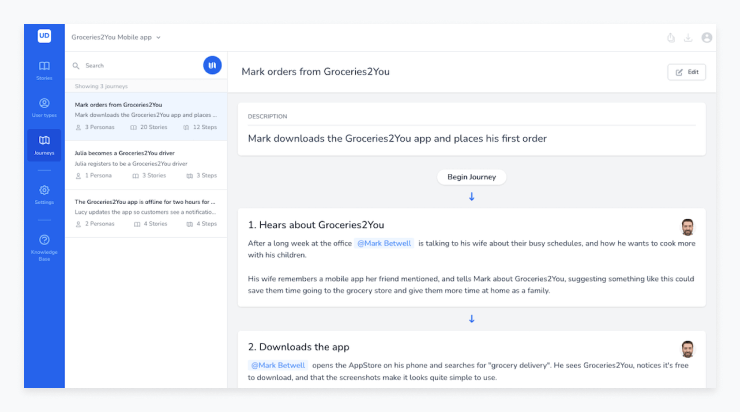
PRO TIP: Deepening user understanding goes beyond mere demographics; it's about capturing the nuances of behavior, motivation, and intent. By leveraging AI, teams can sift through vast datasets—spanning user interactions, feedback, and even social media sentiment—to sculpt detailed and dynamic user personas.
Integrating more data into the storyboarding process ensures a design that's not just based on broad user categories, but on authentic, data-driven insights into your audience's evolving needs and desires.
Rapidly Generate UX/UI Design Ideas
AI enables quicker initial ideation and conceptualization, accelerating the development cycles, and propelling MVPs to market-readiness with minimal design costs.
AI-enabled design platforms harness vast data inputs, extrapolating insights to suggest designs grounded in prevailing trends, user tendencies, and even a brand's unique ethos.
Tips to get started:
- Harness predictive design - Engage AI to proactively fashion layouts, curate color themes, or concoct UI elements that are true to your product idea and resonate with your target demographic.
- Foster AI collaboration for instant feedback - Team up with AI tools for instantaneous critiques on design drafts, gaining insights into probable user interactions and potential refinements.
- Blend AI with human ingenuity - Set AI-generated ideas as your base canvas, then overlay with intuitive tweaks, aligning with brand values and standout features.
AI Tools to Try:
- Uizard - An agile AI-driven UI design apparatus that empowers creators to conceive wireframes, sketches, and prototypes in mere moments.
- Visily - An AI-centric wireframe solution tailored for those outside the design domain, facilitating the crafting of eye-catching software sketches and prototypes.
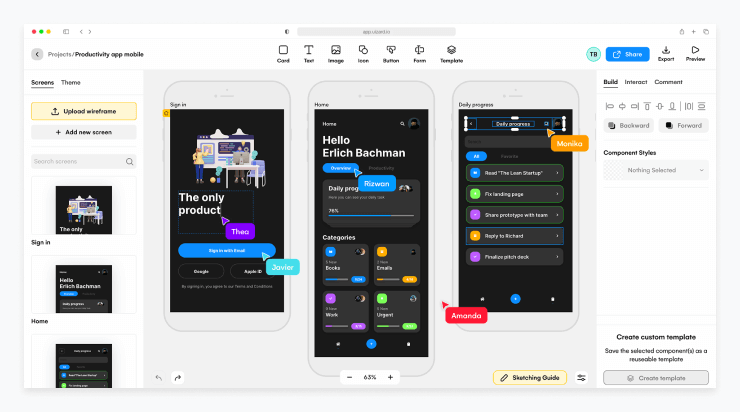
Read More: 8 AI Design Tools to Boost Your Team’s Creative Capacity in 2023
Use Predictive Analytics to Select the Core Features
Choosing the right features is critical when developing an MVP. The goal is to find a balance: you want enough features to attract users but not so many that the product becomes complicated or takes too long to build. In the past, teams often relied on gut feelings or limited feedback to make these decisions.
AI analytics tools offer a compelling way for businesses to cut through the noise and extract meaningful insights from their data without the work and expense of manually connecting diverse data sets and building custom pivots.
Tips to get started:
- Amass historical data - Collate data on user behaviors and feedback from past projects or similar products in the market.
- Harness predictive analysis - Leverage AI to identify features that will most likely enhance user engagement, retention, and overall satisfaction.
- Integrate stakeholder feedback - Marry AI insights with feedback from stakeholders, ensuring a synergy between business goals and user expectations.
AI tools to try:
- Userdoc - Leverage AI assistance to build better software requirements. Save hours creating expert user stories, acceptance criteria, user personas, and user journeys.
- Kameleoon - Specializes in feature experimentation, allowing teams to test and determine which features resonate most with users.
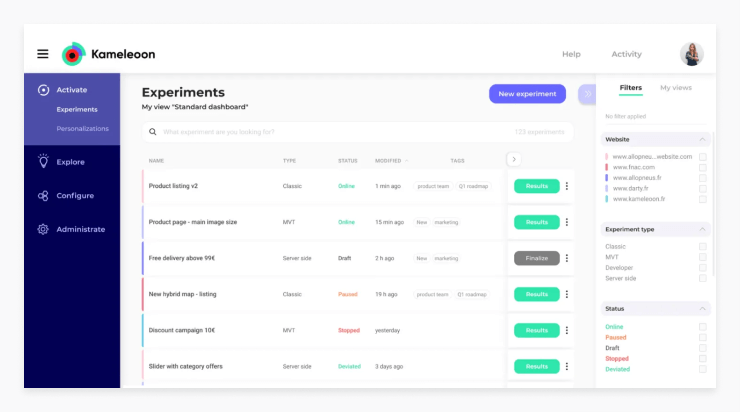
Develop AI-Driven Personalization to Improve User Engagement
User engagement is often the deciding factor between a successful product and one that falls short. Especially in today's data-rich environment, generic approaches may fail to captivate the target audience.
One way to significantly boost engagement is through AI-driven personalization. By delivering tailored experiences from the outset, you're more likely to resonate with your target audience.
How to get started:
- Define personalization goals - Clearly outline what you aim to achieve with AI personalization. For instance, if it's generating report templates, determine the variability and customization you want to offer.
- Personalization through data patterns - Utilize AI to sift through user data, identifying patterns and preferences. This can help in tailoring features or content that better align with what users frequently access or prefer.
- Real-time adaptation - Harness AI tools capable of adjusting features in real-time based on ongoing user interactions. Such dynamism ensures the user experience continuously evolves to match user behavior.
AI tools to try:
- DataRobot - An enterprise AI platform that can be used to predict user behaviors, preferences, and thus, assist in tailoring content or features like report templates.
- Personalizer by Azure - Uses reinforcement learning to provide real-time personalization, adapting based on user actions and feedback.
- Optimizely - While known for A/B testing, its adaptive algorithms can also be leveraged for dynamic content personalization, perfect for MVPs aiming for a tailored user experience.
Conclusion
In a fast-paced digital landscape, building an MVP swiftly yet effectively is more crucial than ever. Leveraging AI tools can significantly accelerate this process, enabling you to make data-driven decisions, optimize design, and enhance user engagement. By combining AI capabilities with strategic planning and human ingenuity, you're positioning your MVP not just for a quick launch, but for long-term success.
Save up to 40% on MVP development budget! Our MVP development company combines a $40k+ library of pre-coded modules with AI-assisted coding to launch your product faster. Get a FREE quote for your MVP today!

